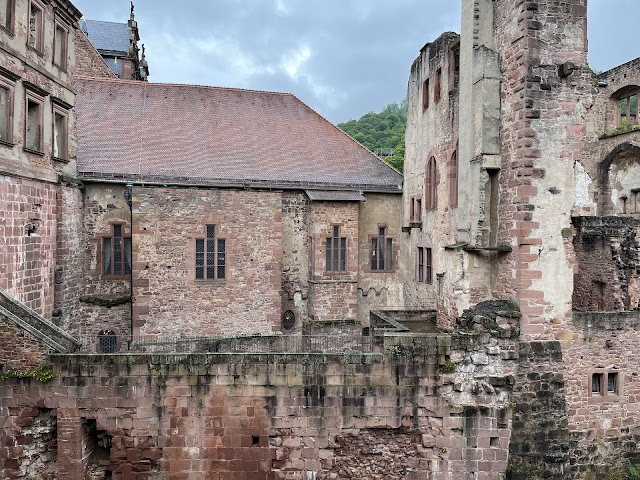An Ancient Town and a Modern City
I mentioned in the last post that Glenn and I took a short trip to Mannheim and Heidelberg. I was so struck by the differences between the two cities. I wanted to understand more about about the sources of theses unmistakable architectural, cultural, and historical contrasts, so I did a bit of reading.
Heidelberg has a documented history going back thousands of years, well before the Roman Empire. Remains of a Celtic fortress on a mountain above the Neckar River have been identified as from the 5th Century BC. In 40 AD, a fort was built and occupied by Roman troops. Roman emperor Valentinian I invested further to the settlement there in 369 AD. Eventually, it was taken over by Germanic tribes. (In fact, human settlement in the vicinity dates back much earlier. In the early 20th Century, the remains of the so-called Heidelberg Man were found in the area, one of the earliest pieces of evidence of human activity in Europe. Those remains date back to, perhaps, 600,000 years ago, but, of course, no supporting historical evidence has survived from that period.)
After the Germanic tribes settled, conversion to Christianity gradually occurred, and various churches and monasteries were established there. In 1386 Heidelberg University was established, making it one of the earliest universities in Europe. Heidelberg thrived as a seat of education and religion for centuries.
Nearby Mannheim's story is quite different. A settlement was established on the site of modern Mannheim quite early--762 AD--but very substantially after Heidelberg. The city was set out on a grid system in 1606, but, perhaps due to its strategic location on the Rhine, it was repeatedly destroyed, during wars in 1622, 1689, and 1795, always being rebuilt in between. Despite this difficult history, Mannheim established itself as an important cultural center during this period, with a particularly strong musical presence.
The 19th Century saw Mannheim's growth as an important industrial center, with the building of a sizeable port on the Rhine. Manufacturing and economic growth followed. And then so did the wars of the 20th Century.
As a major industrial center, it is not surprising that Mannheim, again, suffered very significant damage during WWII. As a result, much of the city has been rebuilt in the last 50-70 years. (There are, of course, still examples of pre-war architecture, but the overwhelming impression one gets is of a modern city.) Heidelberg, on the other hand, was largely spared during WWII (and presumably many previous wars, as well). The story involving Heidelberg during WWII is interesting and involved some unauthorized negotiations between Americans and Germans. Apparently, the American commander who had been given orders to bomb Heidelberg was hesitant due to its historic, educational, and cultural importance. He contacted the Burgomeister and negotiated with him to convince the Nazis to leave Heidelberg. They did and the city was spared.
As a result, it retains its narrow cobbled streets, centuries of architectural heritage, and charm of a very old city.
To illustrate the striking contrasts between the two locations, I include two photo-essays. The first is of the Heidelberg Castle and various parts of it that have been built over centuries.
And here is a collection of murals, graffiti, and public art in Mannheim.














Comments
Post a Comment